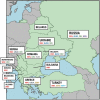West Nile virus and other mosquito-borne viruses present in Eastern Europe
- PMID: 29979950
- PMCID: PMC6225508
- DOI: 10.1080/20477724.2018.1483567
West Nile virus and other mosquito-borne viruses present in Eastern Europe
Abstract
Eastern Europe (EE) has been severely affected by mosquito-borne viruses (moboviruses). In this review, we summarize the epidemiology of moboviruses, with particular attention to West Nile virus (WNV). The study of WNV human cases in EE between 2010 and 2016, revealed that the epidemiology of WNV in EE is complex with the combination of introduction of different WNV strains from lineages 1 and 2, and the establishment of endemic cycles. We found a positive correlation between the risk of WNV re-emergence in an area and the number of human cases reported in the previous year. We also report the main ecological and biological characteristics of the key mosquito species vectors of moboviruses. Recent expansion of invasive mosquito species in EE, mainly Aedes albopictus but also Aedes aegypti and Culex quinquefasciatus, may result in new scenarios with an increased risk of transmission of moboviruses. Main gaps of knowledge in relation to moboviruses and their vectors in EE are identified. Understanding the epidemiology of moboviruses in EE is essential for the improvement of their surveillance and the control of the diseases they cause.
Keywords: Culex and Aedes mosquito; Eastern Europe; Mosquito-borne viruses; West Nile virus.
Figures



References
-
- Vasilakis N, Gubler DJ.. Arboviruses : molecular Biology, Evolution and Control. UK (Poole).: Caister Academic Press; 2016.
-
- Petersen LR, Jamieson DJ, Powers AM, et al. Zika virus. N Engl J Med. 2016;374:1552–1563. - PubMed
-
- WHO [Internet]. Yellow Fever - Brazil 2017. [cited 2017 Nov 11]. Available from: http://www.who.int/csr/don/13-january-2017-yellow-fever-brazil/en/
Publication types
MeSH terms
LinkOut - more resources
Full Text Sources
Other Literature Sources
Medical
